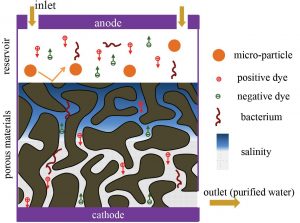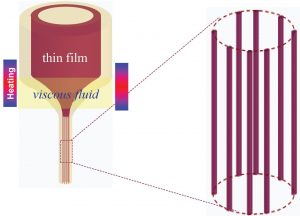Our research group mainly focuses on complex fluids and its technology applications. Relying on the interdisciplinary background (including physics, materials, chemistry, optics and mechanics) and utilizing various manipulation approaches (such as electric, optical, magnetic and thermal fields), particularly we are exploring complex fluids from two perspectives: one perspective is the basic research to explore physical phenomena and the underlying mechanisms (including droplets, bubbles , vapor steam, electroosmotic flow, electrolyte, fluid instability, etc.); the other perspective is the relevant technological applications for the sustainable environment, energy and among others (such as nanotechnology, desalination, solar steam, water purification and treatment, etc.).
Ongoing projects in our group (2016-)
-
Shock electrodialysis
-
Steam and bubble induced by light
-
Liquid bridge under electric filed
-
Instability of a liquid film
-
Others: magnetic droplets, hydrophobic and hydrophilic surface
Previous research topics (Before 2016)
1. Electrokinetics and shock electrodialysis for desalination
The availability of fresh water as a global concern demands advances in water purification technologies. The most difficult step is the removal of dissolved salts, especially multivalent ions. Reverse osmosis is widely used for large-scale seawater desalination, but electrochemical methods, such as classical electrodialysis and capacitive deionization, can be attractive for brackish or wastewater treatment and for use in compact, portable systems.

[Deng, et al, Desalination 357, 77, (2015)]
2. Fluid instability and in-fiber nanostructures
Capillary instability, or breakup of a cylindrical liquid thread into a series of droplets, is perhaps one of the most ubiquitous fluid instabilities and appears in a host of daily phenomena from glass-wine tearing and faucet dripping to ink-jet printing. The study of this Plateau-Rayleigh capillary instability has a long history of over 150 years.

[Deng, et al, Optics Express 19, 16273, (2011)]
3. Magnetic pattern and data storage
Research on magnetic nanostructures for data storage in the commercial market has been developing rapidly in the last two decades. Many experimental properties of magnetic nanostructures, including exchange bias and antiferromagnetic domains, are complicated due to the electron charge and spin freedoms. A series of theoretical work was performed to investigate the physical mechanism of these properties. Particularly, by extending the band gap from electron and photon to magnon, the magnon energy gap was proposed in an artificial structure for spintronics application.

[Deng, et al, Physical Review B 65, 132406 (2002)]
